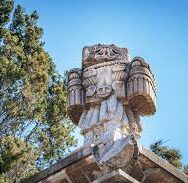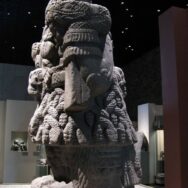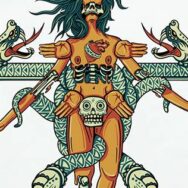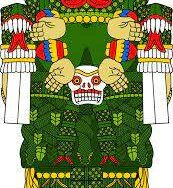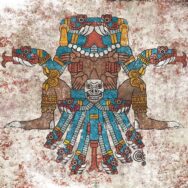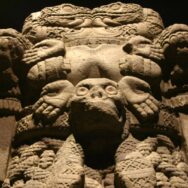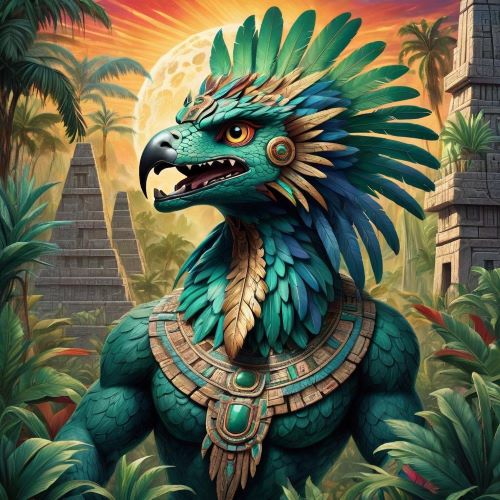Coatlicue : The Earth Goddess
Listen
At a glance
| Description | |
|---|---|
| Origin | Aztec Mythology |
| Classification | Gods |
| Family Members | Huitzilopochtli (Son), Coyolxauhqui (Daughter) |
| Region | Mexico |
| Associated With | Human Sacrifice |
Coatlicue
Introduction
Coatlicue, the Aztec goddess of the earth also known as the Serpent Skirt, was regarded as an old woman who represented the ancient world’s worship of the Earth. She was worshipped during the spring and autumn seasons in the Aztec tradition.
In Aztec mythology, she was a priestess who was tasked with maintaining the shrine on the sacred mountain Coatepec. Her image features a dualism: Her face is made up of two fanged serpents, and her skirt is made up of interwoven snakes. She also feeds on dead bodies as the Earth consumes all that it has left with her clawed fingers and toes.
Physical Traits
In addition to her skirt, which is made up of snakes, she was also known to wear a necklace that featured human hearts and alternating hands. She was commonly portrayed with a face of serpents in place of a human head, and her hands were likewise replaced with snakes. This use of Aztec iconography suggested that Coatlicue had been dismembered, with the twin head snakes possibly representing gouts of blood. Her feet are giant jaguar claws. A serpent of blood flows from beneath her skirt of serpents.
Another sculpture shows Coatlicue with her head still intact. However, her face is partly skeletonized and de-fleshed. Her nose is missing, revealing the cavity and yet she still has flesh on her lips, which are open to reveal bared teeth.
Family
One day, while Coatlicue was sweeping, she noticed that a ball of feathers had come from the heavens. When she tucked it into her belt, it impregnated her. The child she gave birth to from this divine impregnation was Huitzilopochtli, the Aztec god of war. However, her other children, including her daughter Coyolxauhqui and her 400 sons, the Centzon Huitznahua, were outraged by her actions and stormed the mountain to kill her.
The story of how Huitzilopochtli was born fully-grown and fully-armed as an invincible warrior happens because one of her Huiztnahua lost heart and did not want to kill his mother. He was able to use his powerful weapon, which was called the xiuhcoatl, to kill his siblings.
Other Names
The classical Nahuatl goddess’ name can be rendered as Coatlicue or Coatl Icue, which means “she who has the skirt made up of snakes”. The name Tēteoh īnnān, from tēteoh, plural of teōtl “god”, + īnnān “their mother”, refers directly to her maternal role.
Powers and Abilities
Nothing is mentioned in the records of Coatlicue having any other powers than being the mother of Huitzilopochtli but she was feared, worshipped and offered sacrifices to by the Aztecs.
Modern Day Influence
The massive sculpture known as Coatlicue was buried during the Spanish conquest as it went against the Catholic teachings. It was eventually unearthed in 1790 and was regarded as an inappropriate pagan icon and buried again. At that time, Antonio Len y Gama, an astronomer and historian, drew sketches of the sculpture and claimed that it was Teoyaomiqui. After it was discovered again in the 20th century, it became one of the most prominent sculptures in the National Anthropology Museum.
Related Images
Frequently Asked Questions
What is Coatlicue the goddess of?
Why was Coatlicue killed?
What does the coatlicue statue symbolize?
The Coatlicue statue represents the Aztec earth goddess’ power. It shows creation (snake skirt) and destruction (skulls, hands), a cycle of life and death. The fearsome image reflects awe for this powerful force.
Who is the husband of Coatlicue?
Aztec myths depict Coatlicue as a widow by the time the story of her miraculous pregnancy unfolds. Her husband was Mixcoatl, the god of the hunt and the night sky. Together, they had several children before his absence in the myths.
How many kids did Coatlicue have?
Coatlicue’s brood was vast. She birthed the war god Huitzilopochtli and the moon goddess Coyolxauhqui, but her most numerous offspring were the 400 celestial sons who became the stars.

